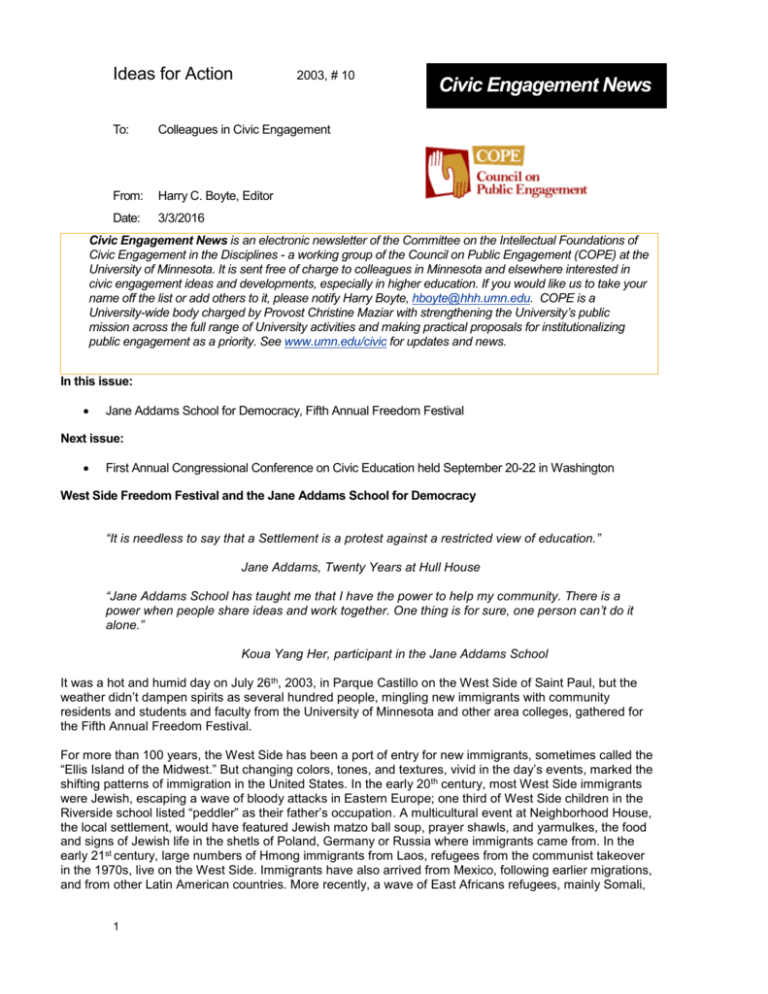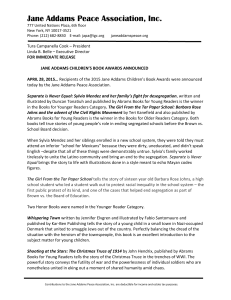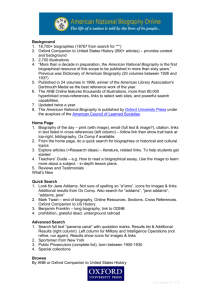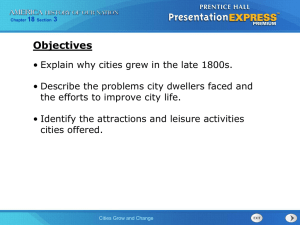Word doc
advertisement

Ideas for Action 2003, # 10 To: Colleagues in Civic Engagement From: Harry C. Boyte, Editor Date: 3/3/2016 Civic Engagement News Civic Engagement News is an electronic newsletter of the Committee on the Intellectual Foundations of Civic Engagement in the Disciplines - a working group of the Council on Public Engagement (COPE) at the University of Minnesota. It is sent free of charge to colleagues in Minnesota and elsewhere interested in civic engagement ideas and developments, especially in higher education. If you would like us to take your name off the list or add others to it, please notify Harry Boyte, hboyte@hhh.umn.edu. COPE is a University-wide body charged by Provost Christine Maziar with strengthening the University’s public mission across the full range of University activities and making practical proposals for institutionalizing public engagement as a priority. See www.umn.edu/civic for updates and news. In this issue: Jane Addams School for Democracy, Fifth Annual Freedom Festival Next issue: First Annual Congressional Conference on Civic Education held September 20-22 in Washington West Side Freedom Festival and the Jane Addams School for Democracy “It is needless to say that a Settlement is a protest against a restricted view of education.” Jane Addams, Twenty Years at Hull House “Jane Addams School has taught me that I have the power to help my community. There is a power when people share ideas and work together. One thing is for sure, one person can’t do it alone.” Koua Yang Her, participant in the Jane Addams School It was a hot and humid day on July 26th, 2003, in Parque Castillo on the West Side of Saint Paul, but the weather didn’t dampen spirits as several hundred people, mingling new immigrants with community residents and students and faculty from the University of Minnesota and other area colleges, gathered for the Fifth Annual Freedom Festival. For more than 100 years, the West Side has been a port of entry for new immigrants, sometimes called the “Ellis Island of the Midwest.” But changing colors, tones, and textures, vivid in the day’s events, marked the shifting patterns of immigration in the United States. In the early 20th century, most West Side immigrants were Jewish, escaping a wave of bloody attacks in Eastern Europe; one third of West Side children in the Riverside school listed “peddler” as their father’s occupation. A multicultural event at Neighborhood House, the local settlement, would have featured Jewish matzo ball soup, prayer shawls, and yarmulkes, the food and signs of Jewish life in the shetls of Poland, Germany or Russia where immigrants came from. In the early 21st century, large numbers of Hmong immigrants from Laos, refugees from the communist takeover in the 1970s, live on the West Side. Immigrants have also arrived from Mexico, following earlier migrations, and from other Latin American countries. More recently, a wave of East Africans refugees, mainly Somali, 1 have settled in the area. The Freedom Festival on July 26th featured bright Hmong dresses, colored kanga cloths from East Africa, and Latino designs -- traditional Mexican attire, Guatemalan fabrics, and Andean wool -- in the Fashion Show, one of the day’s events. Foods included a range of dishes that would have struck earlier immigrants as amazing. Smells and sounds of Africa, Asia, and Latin America filled the air. Yet if cultural tones testified to dramatic changes, the cultural politics of the day might have struck an observer with its similarities, a mingling of dedication to a new home and its democratic ideals with celebration of immigrant traditions that was at the heart of earlier settlement practices. On the one hand, the Fifth Annual Freedom Festival of the Jane Addams School for Democracy conveyed exuberant patriotism. Soua Yang of the JROTC led the Color Guard troupe in a presentation of colors; Margaret Post, a recent graduate of the Humphrey Institute, gave a stunning rendition of the Star Spangled Banner. The day’s event recognized a long list of citizens who passed the citizenship test in the last year, while State Senator Mee Moua, the first Hmong elected state official in the nation, elected with the involvement of many in attendance, delivered a short speech in praise of freedom and democracy. On the other hand, as in earlier settlement houses, such celebration of democratic ideals were phrased in distinct and diverse cultural accents, and included a strong embrace of immigrant heritages as well. The stage in the park was lit by a giant torch, made by the Spanish Circle from parachute fabric and poster board, with a fan giving the impression of huge flames. The torch used symbols for freedom from around the world. A Peruvian man, Eduardo Jurado, dedicated it to the idea of freedom in our world today and to the work of the late Senator Wellstone. An Ecuadorian woman, Ines Rodriguez, later dedicated a tree that was planted in Wellstone’s honor. Hmong youth gave a presentation on how freedom is celebrated in their heritage. Guled Abdi and Yassin Ahmed told the story of the Somalis’ departure from Somalia, their journeys, and their arrival and participation in Jane Addams and the local community. Hmong musicians sang traditional folk songs from Southeast Asia. Shelley Quiali of Teatro del Pueblo led children in a play adapted from a Hmong folk tale, The Tale of the Suns and Moons. Young people translated a summary of the play into different languages to the audience. Jane Addams’ Hull House of the early 20th century, and its sister settlements such as Neighborhood House, founded on the West Side by Jewish women in 1897, rested on a view of America as a diverse commonwealth that is a work in progress, enriched by diverse traditions and immigrant cultures. The Jane Addams School for Democracy a hundred years later renews this vision. “Everyone is a teacher, everyone is a learner” The Jane Addams School for Democracy (JAS) began in 1996 as a partnership among new immigrants on the West Side of St. Paul, the Center for Democracy and Citizenship at the Humphrey Institute and the College of Liberal Arts at the University of Minnesota, Neighborhood House settlement, and the College of St. Catherine. JAS has involved over 1000 students from the University, as well as many faculty and staff, in its seven years. JAS has grown rapidly since its beginning in 1996. By the fall of 2003, on Monday and Wednesday evenings seven “learning circles” gather, mingling new immigrants and American born English speakers. The circles include “Hmong circles,” one “Spanish circle,” one “East African circle,” one “organizing circle,” one “homework group,” for high school students, and one “Children’s Circle.” Most nights, nearly two hundred participate. Ongoing projects and actions also meet outside the evening meetings. The overall philosophy stresses that “everyone is a teacher, everyone is a learner.” and the reciprocal, interactive quality of the space often has strong impact on participants. Exchange and learning also mean different things to different people. For immigrant youth, for instance, JAS often provides resources for forming more complex identities, balancing ethnic traditions with American culture. “I came to the states when I was very little, and my parents don’t talk about the tragedies they experienced in Laos,” said one college student active in JAS for five years, since the beginning of her high school experience. “[The Jane Addams School] was an opportunity not only to help create something but also learn about myself, who I am and where I came from. It’s been very interesting to listen to the women and to hear the stories. I Page 2 needed to take time to learn about my Hmongness…where I came from, what my language is like, what my people have been through. It’s been a journey of self-discovery. It has given me confidence to know at that place we can all be equal.” For students from the University of Minnesota and other area colleges, whose orientation includes an intense emphasis that they are group members, learning as well as educating, not there to provide “community service,” JAS often provides a first time encounter on a relatively equal basis with people from far different cultural backgrounds. “Jane Addams [School ] is a public space where ordinary people are valued for who they are, where they can let their voices be heard even if they disagree with others, and where they are able to let their talents and abilities show through,” said Mary Harrison, a Humphrey Institute graduate student. Harrison participated in the “Hmong Learning Circle” at JAS in the spring of 2003. “At the Jane Addams School, everyone is a teacher and everyone is a learner,” Harrison said, voicing JAS’s stated philosophy. “I found that even while I was primarily a ‘teacher’ as we studied for the [naturalization] test, I still learned a lot. I mostly learned by trying to teach the concepts of freedom and democracy. Having to find ways to illustrate showed me how contextual they are, and challenged me to think of what they meant to me…I had always thought of citizenship and democracy in a very formal way. Now I see that it has at least as much if not more to do with empowering ordinary people…” As Harrison suggests, Jane Addams School is also a school for politics, in multiple ways. Learning citizenship means not only studying for the test but also making its questions about branches of government and their functions, political events in American history, names of elected officials relevant. Events in 2003 included meetings with three Minnesota state representatives with large immigrant populations; visits by Senator Mee Moua, Judge and First Lady Mary Pawlenty, wife of the Republican governor of Minnesota, to hear about the workings of the judicial system; excursions to the state capitol; visits in July by Democratic and Republican chairs of state senate and house committees on health and human services and education to discuss budget cuts and a number of other events. All involved careful preparation, training, follow-up debriefing, and often a mix of learning and political debate and challenge, especially in a climate where new immigrants were acutely affected by huge pending budget cuts. “I think Democrats and Republicans should stop trying to blame each other and work together,” said one man, in the July public forum. JAS looks forward to another year of exploring and celebrating the meaning of democracy. It meets twice a week at Humboldt High School. For information on the JAS, contact D’Ann Lesch at 626-7690 or Durbaniak@hhh.umn.edu. Page 3







